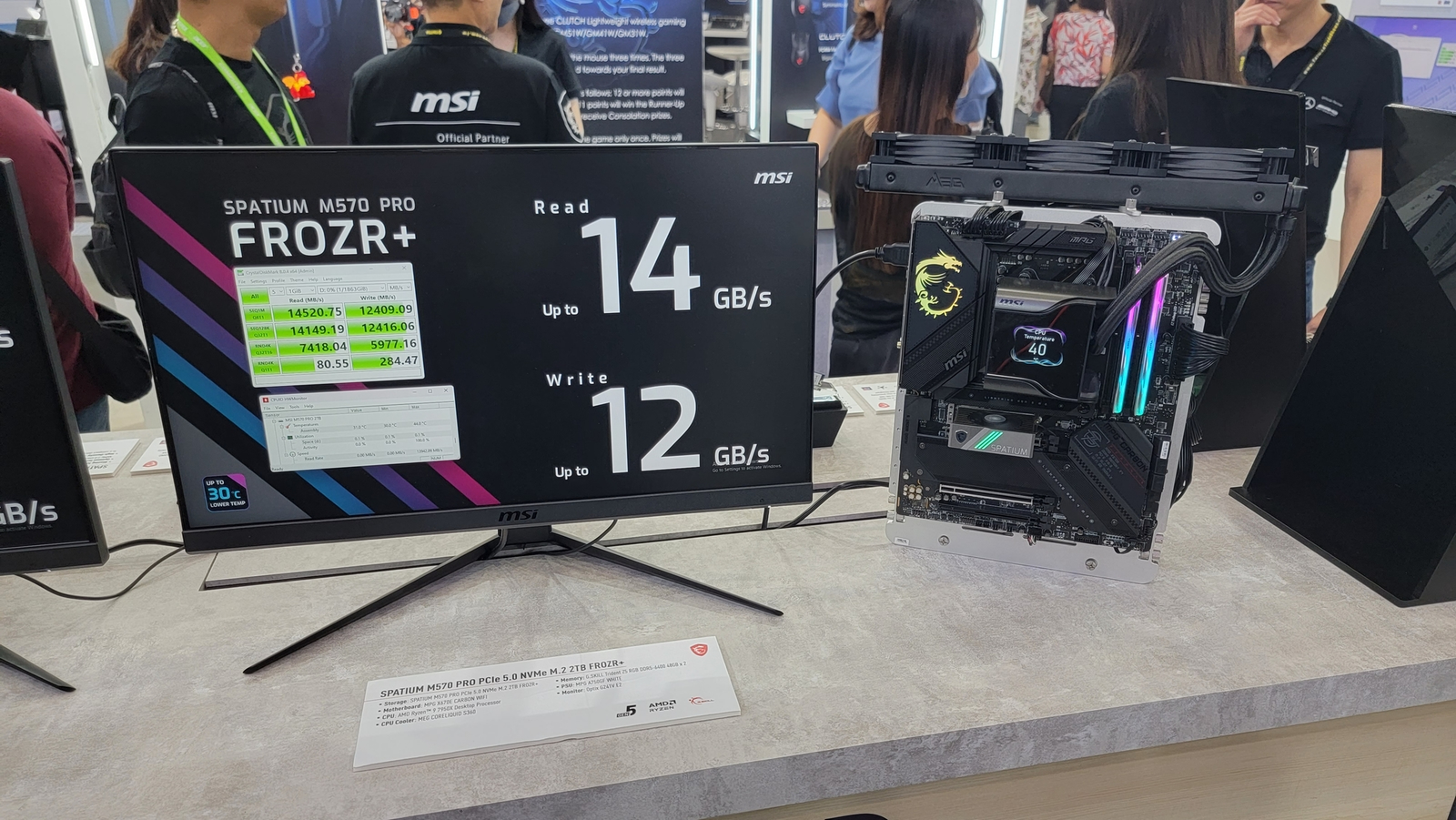MSI Spatium M570 Pro PCIe 5.0 SSD Tops 14.2 GB/s, up to 23 GB/s in RAID

It looks as though MSI is nearly ready to push its Spatium M570 Pro PCIe 5.0 SSD out the door. The company showed off its latest SSDs at its Computex booth in Taipei this week, and we were able to get up close and personal with two versions of the SSD. We first saw the SSD earlier this year at MSI’s CES booth, where it hit sequential read and write speeds of 12,000 MBps and 10,000 MBps, respectively. In the months since that early look, MSI was able to ratchet up performance to place it among the fastest PCIe 5.0 SSDs for 2023.
MSI showed off the Spatium Pro M570 Pro in Frozr and Frozer+ versions. The former has a massive, passively cooled heatsink with beefy pipes to dissipate heat. The company says that this arrangement reduces temperatures by up to 20 degrees Celsius. The Frozr+ ups the stakes with a Torx 5.0 fan and ARGB lighting. The fan helps reduce temperatures by a further 10 degrees Celsius. Performance is identical between the Frozr and the Frozr+, but the latter runs cooler under load.
MSI’s latest performance benchmarks from CrystalDiskMark show the Spatium M570 Pro surpassing 14,200 MBps in sequential reads, while sequential writes come in at well over 12,000 MBps. That puts the read performance slightly behind the T-Force Z54A but ahead in write performance. However, we must caution that there’s more to SSD performance than the raw sequential read/write speeds, but MSI is still looking very strong with this new entry into the PCIe 5.0 SSD field.
But that isn't all. MSI also showed off the Spatium Pro M570 Pro Frozr running in RAID 0, where sequential reads jumped to 22 GBps, while sequential writes climbed to 23 GBps.
The Spatium M570 Pro family uses the Phison PS5026-E26 controller, which we expect to see in the bulk of PCIe 5.0 SSDs released this year. The aforementioned T-Force Z54A used the Innogrit IG5666 controller. The SSD also uses 232-layer 2,400 MTs NAND. As with almost every PCIe 5.0 SSD we’ve seen so far, the M570 Pro features a beefy heatsink and a vapor chamber plate to maintain consistent performance under load. Without a sufficient cooling solution, PCIe 5.0 SSDs are highly susceptible to thermal throttling, which explains the elaborate setups in place.
The less performant Spatium M570 (10,000 MBps for sequential reads and writes) is already available from retailers in 1TB and 2TB capacities. For example, the 2TB Spatium M570 costs $349.99 at Newegg. However, MSI has yet to elaborate on availability for the Spatium M570 Pro other than to say that it would be available in Q2, which is quickly coming to a close.
The Spatium M570 Pro Frozr and Frozr+ will be available in 1TB, 2TB and 4TB capacities when they launch in Q3 2023, and we’re expecting that it will come with a generous pricing premium over their “non-Pro” sibling.
Get Tom's Hardware's best news and in-depth reviews, straight to your inbox.

Brandon Hill is a senior editor at Tom's Hardware. He has written about PC and Mac tech since the late 1990s with bylines at AnandTech, DailyTech, and Hot Hardware. When he is not consuming copious amounts of tech news, he can be found enjoying the NC mountains or the beach with his wife and two sons.
- Paul AlcornEditor-in-Chief
-
imsurgical Reply
I hear you, but if the 2TB "non Pro" is $349, then you have to imagine the Pro series will easily be anywhere from $50-100 more.DotNetMaster777 said:Spatium Pro hope to be not too expensive !
Can't imagine, once the Pro releases, that it will take over the pricing of it's counterpart for these early adopter models. -
Amdlova Nice put a brick on your motherboard... "now you will choose the hardware after you select your pci 5.0 ssd." Your motherboard not fit at all on this device.Reply -
DavidLejdar Eh... Space as such isn't necessarily the issue for a SSD cooler, when one has an AIO for the CPU (instead of an air cooler tower). But if this particular SSD cooler expects air clearance on the side of the GPU, then it wouldn't be an option on my current MB.Reply
And it shows that the standard MB size is arguably starting to be too small. Currently it still works. E.g. I have two M.2 slots inbetween MB and GPU, and a Gen3 SSD works fine enough there (with the case offering the option to mount vents at the bottom). But a Gen4 SSD might have a heat issue there even with a (thin) heatsink, in particular as GPUs themselves seem to move towards emitting more heat. So, in a arguably not that far future, when some may want to mount 2 or more Gen5 SSDs, the current MB designs seem to fall short in such regard. Which makes me wonder what an improved MB design could look like if one wouldn't want to go only E-ATX...

